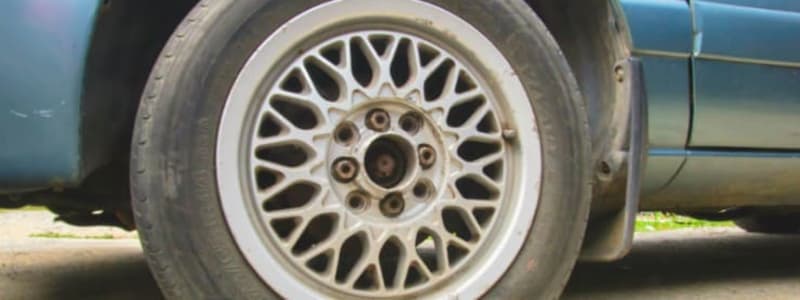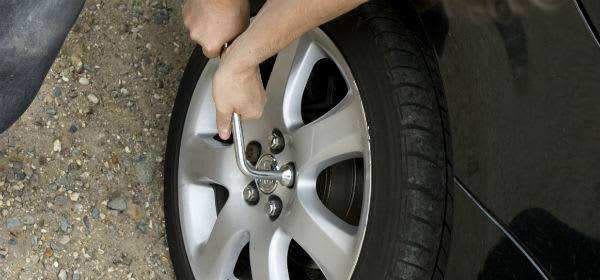
Getting a flat tyre is probably one of the most inconvenient things that can happen to you whilst driving. Unfortunately, it is also extremely common, so the likelihood is that you will get one at some point during your life. This is why it is always important to be prepared so that you know exactly what to do whether it happens tomorrow, in six months or 20 years from now.
How to change a flat tyre
- Hazard lights – the minute you realise that you have a flat tyre, turn on your hazard lights so that other cars give you the space you need. Keep them on whilst parked. If you have a triangular hazard sign put that out in the direction facing the traffic on your side of the road
- Take the spare wheel out of the boot
- Use a spanner to loosen the nuts of the affected wheel
- Insert the jack under the car to lift it slightly off the ground
- Take off the nuts completely
- Pull the wheel firmly from the car
- Put the spare wheel into position onto the car
- Place the nuts back on to secure the spare wheel
- Lower the car again and remove the jack
- Make sure that the nuts are tight enough
- Put the flat tyre back in the car where you found the spare
- Turn off your hazards and pull away slowly
- Drive with extreme caution to the nearest garage to have the car fixed by a professional.

How to react if you get a flat tyre whilst driving
It can be a bit of a shock if the tyre goes whilst you are driving the car; especially if it has never happened to you before. The important thing is to remain calm, don’t panic as you could make a sudden movement which could make the situation even worse. Try not to steer too hard or brake too quickly and get yourself off the road into a safe place to stop as quickly as possible.
Are you ready?
Just because there are lots of alternative ways to deal with the situation doesn’t mean that you should get out of knowing how to do it. For those of us who are able, being able to change a tyre is much like having taken a first aid course: hopefully you will never need to use your skills but they could make all of the difference in the unlikely event that you do. What would happen if you broke down miles from anywhere and your phone had run out of battery charge? There are loads of videos on YouTube which can talk you through the process step-by-step so that you would know exactly what to do if you needed to. You will need to be aware that all cars are different; so the exact process of changing a wheel on your particular model might be slightly different to the ones shown in the videos, but the basic principle will be the same.
Most cars will have space for a spare tyre in the boot but just because your car has a spare wheel doesn’t mean that it’s in good working order. If you’ve never had you’re spare wheel checked to make sure that it is roadworthy then it is a good idea to get someone to look it over. You should also make sure that you know exactly how to access your spare. Different makes and models of cars keep the spare wheel in different places and require you to press different buttons or pull different levers to physically get it out. Have a look at yours to make sure that you know how to get to it in case you do come to need it one day.
Should I change it myself?
The majority of people, of all ages and genders, admit that they would not feel confident changing a wheel themselves. Many express concerns that the wheel would just fall off after a few miles and would rather drive on the punctured tyre than risk damaging the rest of the car. If you know what to do, or feel comfortable following the instructions in the car manual or from an online video then there is nothing stopping you from changing the tyre yourself. But if you have any worries or doubts then it is probably worth leaving it to the professionals.
What if you don’t have a spare wheel?
It is no longer seen as quite such a necessity to have to roll up your sleeves at the side of the road and change a tyre yourself. Car manufacturers are always looking at ways to improve their overall products and they have conducted numerous surveys and a great deal of market research which suggests that changing a flat tyre really doesn’t appeal to most people. Many modern cars don’t come with a spare wheel and just have a tyre-repair kit in the glove box instead. It is becoming more and more common for manufacturers to fit ‘run-flat’ tyres to cars instead. These tyres are built to resist deflation and if they get punctured motorists can still drive their cars at slower speeds for a short distance to get safely home or to a mechanic. When buying a new car it is well worth checking how it is equipped in the event of a flat tyre; and if you already have a car but don’t know what equipment it has to deal with a puncture, you should probably find out before you next get on the road.
If you do get a flat tyre and you don’t have a spare then you could try using a sealant to temporarily repair the hole if you can find it. If not, you will have to call for roadside assistance to come and change it for you or to tow you to the nearest garage.
How would I get a flat tyre in the first place?
Punctures can happen for many reasons. The most common is driving over something sharp in the road which gets stuck in the tyre and pierces it after several rotations of the wheel. Driving over things like nails, shards of broken glass or even sharp stones can puncture one or more tyres. They can also be punctured by hitting something at speed. If you reverse into a pavement or a signpost then you can damage your tyres. This can cause them to rupture instantly or may create weak patches which are more susceptible to being punctured later on. You can also get a flat tyre more easily if your tyres are old and very worn.
Why you shouldn’t drive with a flat tyre
There are several reasons why you shouldn’t drive with a flat tyre.
- Firstly, the car may respond differently to your steering which could result in it going in a direction you weren’t expecting and might cause an accident.
- Secondly, you could damage the tyre completely and ruin the chances of a mechanic being able to fix it.
- Thirdly, the tyre could actually end up coming off the wheel itself, the wheel would then be exposed to the road and could be severely damaged. Replacing a wheel is a much bigger and more expensive job than repairing a flat tyre.
How to fix a flat tyre
How you fix a tyre will depend on the reasons for the puncture. If the tyre has run flat because it was very worn then it would be better to replace the whole thing. If the tyre has been punctured by a sharp item then there could be more damage done than meets the eye. If there was a collision which caused the puncture then it could have made a much larger rupture which would be very difficult to repair. Since fixing a tyre is not always straight forward, it is a much better idea to take the car to a mechanic to ask for a professional opinion. Flat or damaged tyres could cause unforeseen problems in the future which might lead to an accident. A qualified professional will find it much easier to spot these problems.
All about Tyres, Tyre change, Winter Tyres and Rims
- Tyres, tyre mounting and wheel change
- New Winter Tyres and Rims
- New Rims or Replacing Your Rims
- What Are 4x4 Tyres?
- What Are Run Flat Tyres?
- Which Are the Best Car Tyre Brands?
- Watch Out with Cheap Part Worn Tyres
- Cheap Tyres Online
- Flat Tyre? - How to Change a Flat Tyre
- Tyre Types and Sizes
- Can I Have Broader Tyres on My Car?
- What is TPMS Tire Pressure Monitoring System
- Eco Friendly Tyres?
- What is Wheel Alignment
- Service for wheel alignment
- What are the Rules for Winter Tyres in the UK?
- How to Tell if Winter Tyre is OK
- Are Your Winter Tyres in Good Shape?
- Save Thousands When You Need New Winter Tyres
- Change Tyre on a Wheel, or Two Sets of Tyres?






